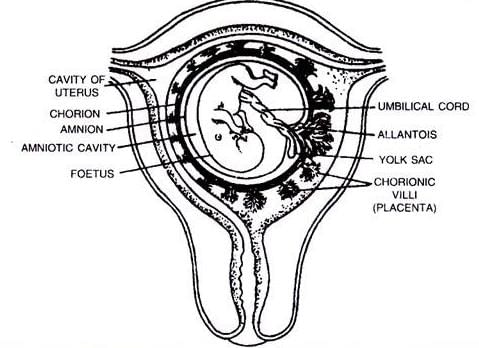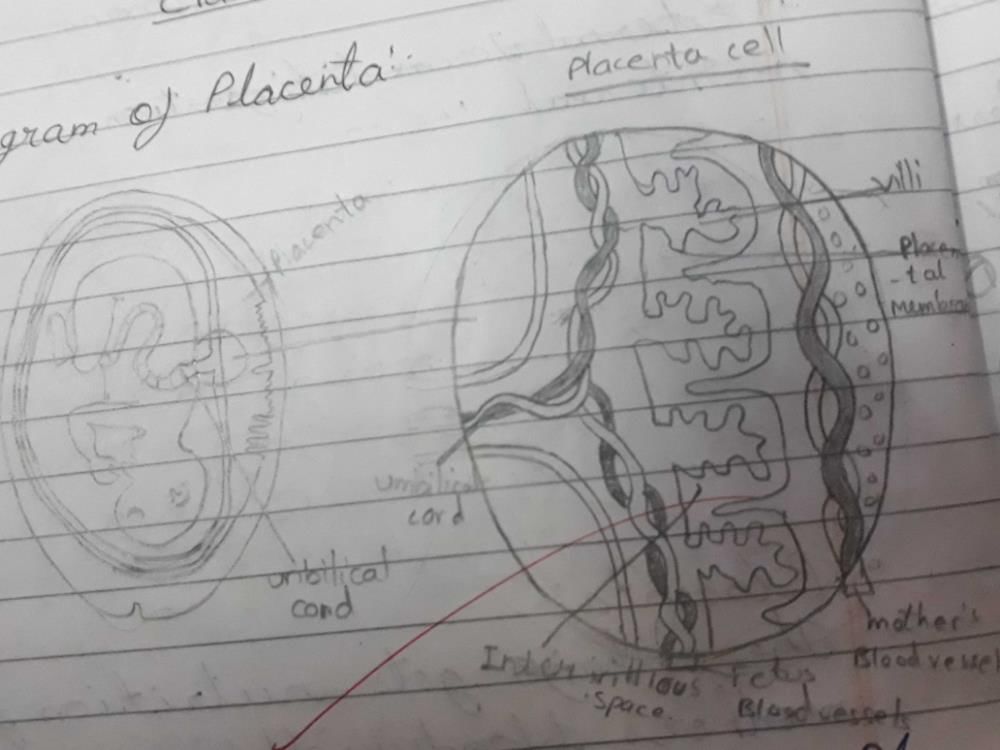Class 10 Exam > Class 10 Questions > Diagram of placenta and planira ?
Start Learning for Free
Diagram of placenta and planira ?
Verified Answer
Diagram of placenta and planira ?
Structure:
Placenta is a structure that establishes firm connection between the foetus and the mother.
From the outer surface of the chorion a number of finger like projections known as chorionic villi grow into the tissue of the uterus. These villi penetrate the tissue of the uterine wall of the mother and form placenta.

 This question is part of UPSC exam. View all Class 10 courses
This question is part of UPSC exam. View all Class 10 courses
Community Answer
Diagram of placenta and planira ?
Diagram of Placenta:
The placenta is a vital organ that develops during pregnancy and connects the developing fetus to the uterine wall. It provides the fetus with essential nutrients and oxygen while also removing waste products.
Structure of Placenta:
The placenta is a flat, circular organ that is typically 6-8 inches in diameter and about 1 inch thick. It consists of two main components:
1. Maternal Side: This side of the placenta is in direct contact with the uterine wall. It is covered by a smooth layer called the decidua basalis, which is formed by the modified cells of the uterus. The maternal side contains numerous blood vessels that supply oxygen and nutrients to the fetus.
2. Fetal Side: This side of the placenta is in direct contact with the fetus. It is covered by a thin membrane called the amnion, which surrounds the amniotic sac. The fetal side contains numerous chorionic villi, which are finger-like projections that increase the surface area for nutrient and gas exchange between the maternal and fetal blood.
Function of Placenta:
The placenta plays a crucial role in supporting fetal development and maintaining a healthy pregnancy. Its main functions include:
1. Nutrient and Gas Exchange: The placenta allows for the exchange of oxygen and nutrients from the maternal blood to the fetal blood. It also facilitates the removal of waste products, such as carbon dioxide, from the fetal blood to the maternal blood.
2. Endocrine Function: The placenta produces hormones that are essential for maintaining pregnancy. These hormones include human chorionic gonadotropin (hCG), progesterone, and estrogen, which help regulate various physiological processes during pregnancy.
3. Immune Protection: The placenta acts as a barrier, preventing harmful substances and pathogens from reaching the fetus. It also transfers maternal antibodies to the fetus, providing temporary immune protection after birth.
Diagram of Planira:
Unfortunately, there is no information available regarding "Planira." It is possible that it may be a term or subject that is not widely recognized or does not exist. Therefore, it is not possible to provide a diagram or detailed explanation for something that is not known or understood.
The placenta is a vital organ that develops during pregnancy and connects the developing fetus to the uterine wall. It provides the fetus with essential nutrients and oxygen while also removing waste products.
Structure of Placenta:
The placenta is a flat, circular organ that is typically 6-8 inches in diameter and about 1 inch thick. It consists of two main components:
1. Maternal Side: This side of the placenta is in direct contact with the uterine wall. It is covered by a smooth layer called the decidua basalis, which is formed by the modified cells of the uterus. The maternal side contains numerous blood vessels that supply oxygen and nutrients to the fetus.
2. Fetal Side: This side of the placenta is in direct contact with the fetus. It is covered by a thin membrane called the amnion, which surrounds the amniotic sac. The fetal side contains numerous chorionic villi, which are finger-like projections that increase the surface area for nutrient and gas exchange between the maternal and fetal blood.
Function of Placenta:
The placenta plays a crucial role in supporting fetal development and maintaining a healthy pregnancy. Its main functions include:
1. Nutrient and Gas Exchange: The placenta allows for the exchange of oxygen and nutrients from the maternal blood to the fetal blood. It also facilitates the removal of waste products, such as carbon dioxide, from the fetal blood to the maternal blood.
2. Endocrine Function: The placenta produces hormones that are essential for maintaining pregnancy. These hormones include human chorionic gonadotropin (hCG), progesterone, and estrogen, which help regulate various physiological processes during pregnancy.
3. Immune Protection: The placenta acts as a barrier, preventing harmful substances and pathogens from reaching the fetus. It also transfers maternal antibodies to the fetus, providing temporary immune protection after birth.
Diagram of Planira:
Unfortunately, there is no information available regarding "Planira." It is possible that it may be a term or subject that is not widely recognized or does not exist. Therefore, it is not possible to provide a diagram or detailed explanation for something that is not known or understood.
Attention Class 10 Students!
To make sure you are not studying endlessly, EduRev has designed Class 10 study material, with Structured Courses, Videos, & Test Series. Plus get personalized analysis, doubt solving and improvement plans to achieve a great score in Class 10.

|
Explore Courses for Class 10 exam
|

|
Diagram of placenta and planira ?
Question Description
Diagram of placenta and planira ? for Class 10 2024 is part of Class 10 preparation. The Question and answers have been prepared according to the Class 10 exam syllabus. Information about Diagram of placenta and planira ? covers all topics & solutions for Class 10 2024 Exam. Find important definitions, questions, meanings, examples, exercises and tests below for Diagram of placenta and planira ?.
Diagram of placenta and planira ? for Class 10 2024 is part of Class 10 preparation. The Question and answers have been prepared according to the Class 10 exam syllabus. Information about Diagram of placenta and planira ? covers all topics & solutions for Class 10 2024 Exam. Find important definitions, questions, meanings, examples, exercises and tests below for Diagram of placenta and planira ?.
Solutions for Diagram of placenta and planira ? in English & in Hindi are available as part of our courses for Class 10.
Download more important topics, notes, lectures and mock test series for Class 10 Exam by signing up for free.
Here you can find the meaning of Diagram of placenta and planira ? defined & explained in the simplest way possible. Besides giving the explanation of
Diagram of placenta and planira ?, a detailed solution for Diagram of placenta and planira ? has been provided alongside types of Diagram of placenta and planira ? theory, EduRev gives you an
ample number of questions to practice Diagram of placenta and planira ? tests, examples and also practice Class 10 tests.

|
Explore Courses for Class 10 exam
|

|
Suggested Free Tests
Signup for Free!
Signup to see your scores go up within 7 days! Learn & Practice with 1000+ FREE Notes, Videos & Tests.


























